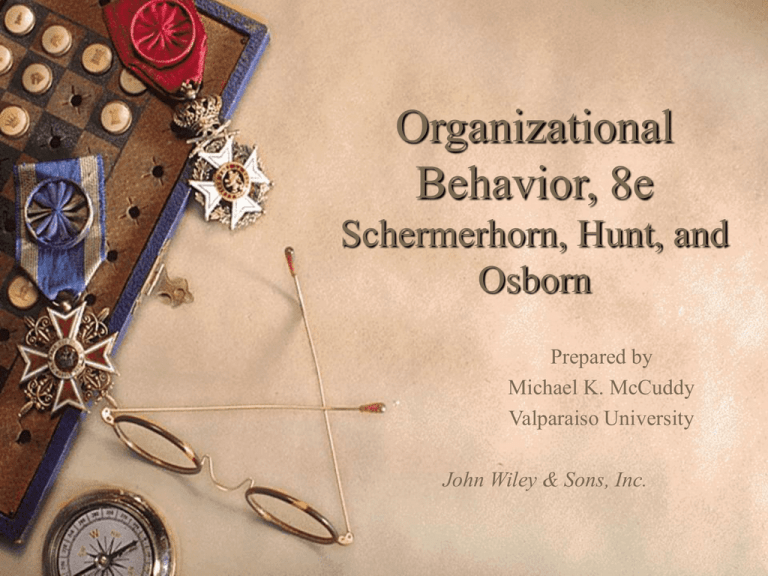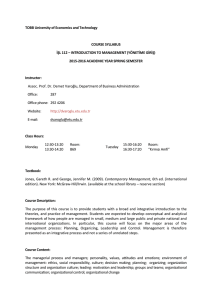
Organizational
Behavior, 8e
Schermerhorn, Hunt, and
Osborn
Prepared by
Michael K. McCuddy
Valparaiso University
John Wiley & Sons, Inc.
COPYRIGHT
Copyright 2003 © John Wiley & Sons, Inc. All rights reserved.
Reproduction or translation of this work beyond that permitted in Section
117 of the 1976 United States Copyright Act without the express written
permission of the copyright owner is unlawful. Request for further
information should be addressed to the Permissions Department, John Wiley
& Sons, Inc. The purchaser may make back-up copies for his/her own use
only and not for distribution or resale. The Publisher assumes no
responsibility for errors, omissions, or damages, caused by the use of these
programs or from the use of the information contained herein.
Organizational Behavior: Chapter 1
2
Chapter 1
Organizational Behavior Today
Study questions.
– What is organizational behavior and why is it
important?
– How do we learn about organizational
behavior?
– What are organizations like as work settings?
– What is the nature of managerial work?
– How do ethics influence human behavior in
organizations?
Organizational Behavior: Chapter 1
3
What is organizational behavior
and why is it important?
Organizational behavior.
– Study of individuals and groups in
organizations.
– Emphasizes high performance organizations.
– Occurs in a global context.
– Dimensions of individual and group behavior.
– Nature of organizations.
– Core processes.
Organizational Behavior: Chapter 1
4
What is organizational behavior
and why is it important?
Shifting paradigms of organizational
behavior.
– Demise of “command-and-control.”
– Emergence of new workplace expectations.
– Critical role of information technologies.
– Belief in empowerment.
– Emphasis on teamwork.
– Concern for work-life balance.
Organizational Behavior: Chapter 1
5
What is organizational behavior
and why is it important?
Organizational behavior and diversity.
– Workforce diversity is the presence of
differences based on:
• Gender.
• Race and ethnicity.
• Age.
• Abel-bodiedness.
• Sexual orientation.
Organizational Behavior: Chapter 1
6
What is organizational behavior
and why is it important?
Organizational behavior and diversity —
cont.
– Valuing diversity is a core OB theme.
• Interpersonal and cultural sensitivity.
– Glass ceiling effect.
• Women and minorities as managers and executives.
• Earnings of women and minorities.
Organizational Behavior: Chapter 1
7
How do we learn about
organizational behavior?
Organizational behavior and the learning
imperative.
– Organizational learning is the process of
acquiring knowledge and utilizing information
to adapt successfully to changing
circumstances.
– Necessity of life-long learning.
Organizational Behavior: Chapter 1
8
How do we learn about
organizational behavior?
Scientific foundations of organizational
behavior.
– Interdisciplinary body of knowledge.
– Use of scientific methods.
– Focus on application.
– Contingency thinking.
Organizational Behavior: Chapter 1
9
What are organizations
like as work settings?
An organization is a collection of people
working together in a division of labor to
achieve a common purpose.
Applies to:
– A wide variety of clubs, institutions, agencies,
businesses, and other organized entities.
Organizational Behavior: Chapter 1
10
What are organizations
like as work settings?
Purpose, mission, and strategies.
– Core purpose of an organization.
– Mission and vision.
– Mission statements.
Organizational Behavior: Chapter 1
11
What are organizations
like as work settings?
People and work systems.
– Intellectual capital
• The sum total of knowledge, expertise, and
dedication of an organization’s workforce.
– Human resources.
– Material resources.
Organizational Behavior: Chapter 1
12
What are organizations
like as work settings?
Organizations as open systems.
– Organizations obtain resource inputs from the
environment.
– Organizations transform resource inputs.
– Organizations return transformed inputs to the
environment as outputs in the form of goods
and services.
Organizational Behavior: Chapter 1
13
What is the nature of managerial work?
Managers:
– Perform jobs that involve directly supporting
the work efforts of others.
– Help other people get important things done in
timely, high-quality, and satisfying ways.
– Assume roles such as coordinator, coach, or
team leader.
Organizational Behavior: Chapter 1
14
What is the nature of managerial work?
The nature of managerial work.
– Managers work long hours.
– Managers are busy people.
– Managers are often interrupted.
– Managers work mostly with other people.
– Managers are communicators.
Organizational Behavior: Chapter 1
15
What is the nature of managerial work?
The management process.
– An effective manager is one whose
organizational unit, group, or team
consistently achieves its goals while its
members remain capable, committed, and
enthusiastic.
– Key results of effective management:
• Task performance.
• Job satisfaction.
Organizational Behavior: Chapter 1
16
What is the nature of managerial work?
Functions of management.
– Planning.
• Defining goals, setting specific performance
objectives, and identifying the actions needed to
achieve them.
– Organizing.
• Creating work structures and systems, and
arranging resources to accomplish goals and
objectives.
Organizational Behavior: Chapter 1
17
What is the nature of managerial work?
Functions of management — cont.
– Leading.
• Instilling enthusiasm by communicating with
others, motivating them to work hard, and
maintaining good interpersonal relations.
– Controlling.
• Ensuring that things go well by monitoring
performance and taking corrective action as
necessary.
Organizational Behavior: Chapter 1
18
What is the nature of managerial work?
Managerial roles.
– Interpersonal roles.
• Figurehead.
• Leader.
• Liaison.
– Informational roles.
• Monitor.
• Disseminator.
• Spokesperson.
Organizational Behavior: Chapter 1
19
What is the nature of managerial work?
Managerial roles — cont.
– Decisional roles.
• Entrepreneur.
• Disturbance handler.
• Resource allocator.
• Negotiator.
Organizational Behavior: Chapter 1
20
What is the nature of managerial work?
Managerial networks.
– Task networks.
• Specific job-related contacts.
– Career networks.
• Career guidance and opportunity resources.
– Social networks.
• Trustworthy friends and peers.
Organizational Behavior: Chapter 1
21
What is the nature of managerial work?
Managerial skills and competencies.
– A skill is an ability to translate knowledge into
action that results in a desired performance.
– Categories of skills:
• Technical.
• Human.
• Conceptual.
Organizational Behavior: Chapter 1
22
What is the nature of managerial work?
Managerial skills and competencies —
cont.
– Technical skills are relatively more important
at entry levels.
– Human skills are consistently important across
all managerial levels.
– Conceptual skills are relatively more
important at top management levels.
Organizational Behavior: Chapter 1
23
What is the nature of managerial work?
Managerial skills and competencies—
cont.
– Technical skills.
• An ability to perform specialized tasks.
• Derives from knowledge of expertise gained from
education or experience.
• Proficiency at using select methods, processes, and
procedures to accomplish tasks.
Organizational Behavior: Chapter 1
24
What is the nature of managerial work?
Managerial skills and competencies —
cont.
– Human skills.
• An ability to work well with other people.
• Emerges as a spirit of trust, enthusiasm, and
genuine involvement in interpersonal relationships.
• Self-awareness.
• Capacity for understanding and empathizing.
• Engages in persuasive communication.
• Deals successfully with conflicts.
Organizational Behavior: Chapter 1
25
What is the nature of managerial work?
Managerial skills and competencies —
cont.
– Conceptual skills.
• An ability to see and understand how the system
works, and how the parts are interrelated.
• Used to:
– Identify problems and opportunities.
– Gather and interpret relevant information.
– Make good problem-solving decisions.
Organizational Behavior: Chapter 1
26
How do ethics influence human
behavior in organizations?
Ethical behavior.
– “Good” and “right” as opposed to “bad” or
“wrong” in a particular setting.
– Ways of thinking about ethical behavior.
• Utilitarian view.
• Individualism view.
• Moral rights view.
• Justice view.
Organizational Behavior: Chapter 1
27
How do ethics influence human
behavior in organizations?
Ethical dilemmas in the workplace.
– Nature of an ethical dilemma.
– Ethical dilemmas occur in relationships with:
•
•
•
•
•
•
Superiors.
Subordinates.
Customers.
Competitors.
Suppliers.
Regulators.
Organizational Behavior: Chapter 1
28
How do ethics influence human
behavior in organizations?
Ethical dilemmas in the workplace — cont.
– Rationalizations for unethical behavior:
• Pretending the behavior is not really unethical or
illegal.
• Saying the behavior is really in the organization’s
or person’s best interest.
• Assuming the behavior is acceptable if others don’t
find out about it.
• Presuming that superiors will support and protect
you.
Organizational Behavior: Chapter 1
29
How do ethics influence human
behavior in organizations?
Organizational social responsibility.
– The obligation of organizations to behave in
ethical and moral ways as institutions of the
broader society.
– Managers should commit organizations to:
• Pursuit of high productivity.
• Corporate social responsibility.
Organizational Behavior: Chapter 1
30
How do ethics influence human
behavior in organizations?
Work and the quality of life.
– Quality of work life (QWL).
• The overall quality of human experience in the
workplace.
– QWL commitment reflects an endorsement of
Theory Y assumptions.
– Work-life balance.
• Job demands should fit personal life and nonwork
responsibilities.
Organizational Behavior: Chapter 1
31






